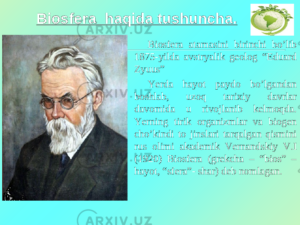SHARE WITH FRIENDS:
Information about the biosphere and noosphere
The concept of "biosphere" was introduced to science by the Australian zoologist E. Zuss in 1875. But the doctrine of the biosphere is Acad. Created by VI Vernadsky.
The biosphere includes 10-25 km of the atmosphere, up to 11 km of the hydrosphere, and up to 3,5 km of the lithosphere, which is the layer where life exists. In other words, the biosphere includes the lower part of the atmosphere (troposphere), the part of the earth's surface covered with ocean, sea, lake and river water (hydrosphere), and the upper part of the earth's crust (lithosphere).
Biosphere - life, living area, the place of the earth where living organisms are distributed. The hydrosphere and lithosphere are interconnected by complex biochemical cycles, as if substances and energies are circulating.
The part of the Earth where living organisms and biogenic waste rocks are scattered is a Russian scientist. VIVernadsky called the biosphere. The biosphere is considered the "shell of life" on our planet and is a set of complex ecosystems consisting of close connections and relationships of living organisms. The biosphere is the active shell of the earth, in which the activity of living organisms serves as the main geochemical factor and as the factor that creates the environment. The biosphere includes living organisms and their habitats. In the biosphere, there are complex interactions between organisms, forming a whole organic system. So, the biosphere is a system in complex motion. In the biosphere, as a result of the exchange of substances, processes such as the reception, accumulation and transfer of energy take place.
VIVernadsky called the totality of all living organisms on our planet living matter. The most important properties of living matter are 3:
-
Total weight of living matter.
-
The composition of living matter.
-
Energy of living matter.
The second component of the biosphere is dead matter. All substances in the biosphere, as well as living organisms, participate in its formation.
The third component of the biosphere is intermediates. They are formed as a result of the joint activity of living and dead matter. Examples of intermediates are soil, eroded rock, and all natural waters.
The 4th component of the biosphere is biogenic matter. They are formed during the life of living organisms and undergo changes. Finally, examples of biogenic materials include coal, bitumen, oil, limestone, etc., which have great potential energy.
The unit of simple primary structure of the biosphere is biogeocenosis. The coexistence of plants, animals, some fungi and microorganisms under certain environmental conditions is called biogeocenosis. VLSukachev introduced this concept to science for the first time.
If several types of plants live together, it is called phytocenosis (plant community). If several species of animals live together, it is called zoocenosis (community of animals).
Biogenoses are diverse and formed depending on the climate and the history and nature of the area. For example, biogeocenoses of forests in tropical regions are much more productive than Arctic tundras, which are much poorer. Biogenoses at the bottom of the ocean are less productive than biogenoses of shallow areas near the coasts of seas and oceans.
It should be emphasized that on the basis of the doctrine of population, an opportunity was created to study many complex and vital processes in nature, that is, biogeocenoses. The study of biogeocenoses is called biogeocenology.
Different tariff components of biogeocenosis in nature combine in the process of living to form a biological entity, i.e. biogeocenosis. Biocenosis (Latin word, "bios" means life, "cenosis" means common) refers to all organisms that have adapted to the same environment and live together in the same place. The size of the biocenosis can be different.
Biocenosis is the sum total of the population of all types of organisms living in a certain geographical area. Such areas differ from neighboring areas or places by the chemical composition of soil and water, elevation of the place, solar radiation and other natural indicators. Plants and animals living in biocenosis are always interacting. The development process of biocenosis usually lasts a long time. A person can change the biocenosis in the direction he likes, depending on his vital needs.
Human society with all its features is the next stage of life development (biogenesis) on earth. As the most powerful natural factor, humans are changing not only our planet, but also the universe. Here is a logical question:
-
What will be the development of man and the biosphere in the future?
-
How can the biosphere be prevented from collapsing?
